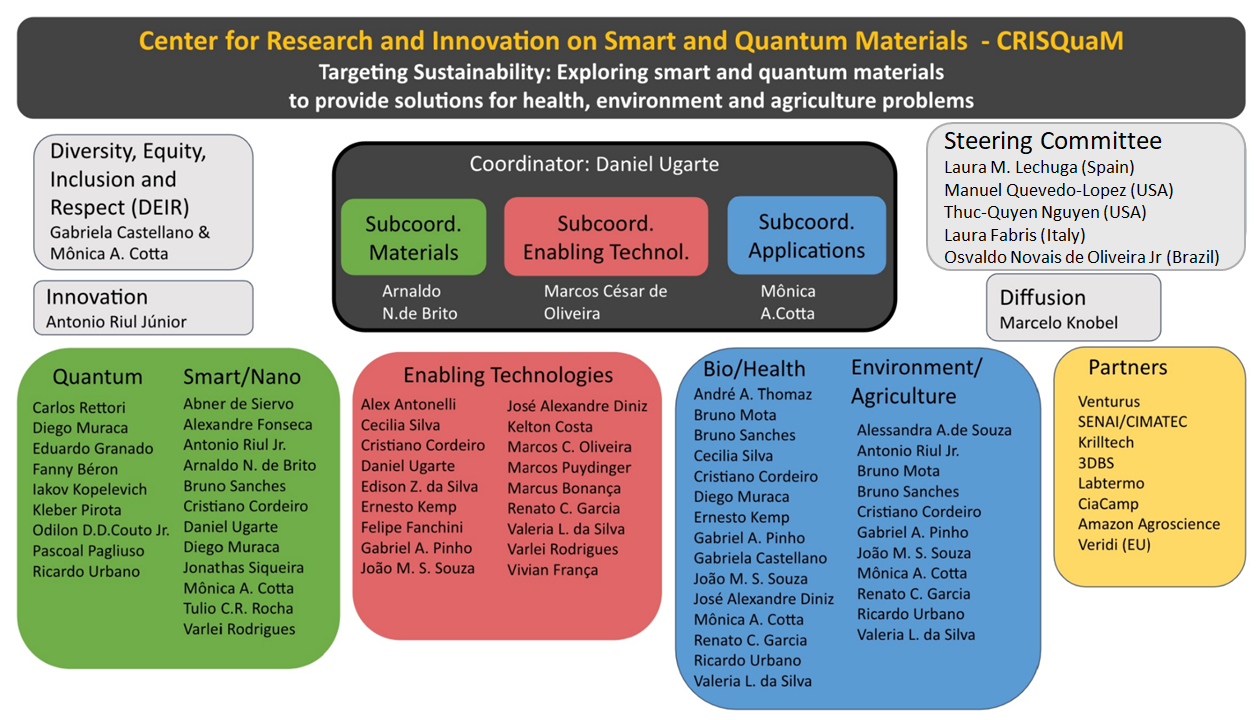BV-FAPESP: research projects supported in this Center
CRISQuaM in the Media: news about the center
CRISQuaM aims to explore the synergistic development of fundamental and applied science to create new materials with high potential for the construction of devices and sensors to address technological challenges related to sustainability, climate change, precision agriculture, ecology, and health. To achieve these goals, we have assembled an interdisciplinary and collaborative research team, integrating expertise across various scientific domains, researching novel materials with high innovation potential. By combining original synthesis methods, advanced characterization techniques, theoretical approaches, computational simulations, quantum technologies, and device construction designs, we aim to drive advances in smart and quantum materials, promoting scientific excellence and technological development. With this, we plan disruptive innovations in instrumentation—including hardware and AI-based tools—as well as in quantum technologies, biomedical devices, and signal processing, in addition to plant bionics, exploring plant-pathogen interactions. Besides research activities, we plan intensive actions in education, dissemination, and communication for the general public, as a modern society should be aware of the challenges humanity faces and how research and technology are essential for responsibly utilizing the planet's limited resources. CRISQuaM's Innovation activities are accelerated through partnerships with several companies in related technologies, many of them Brazilian. Finally, all activities of the Center are managed in accordance with diversity, equity, and inclusion goals and best practices.
The Center brings together scientists, engineers, and innovators in a collaborative effort to apply materials science and quantum technologies at the cutting edge, designing new materials and nano(bio)sensors for advanced diagnostics. The Center has a team capable of producing a wide range of (nano/micro) materials, along with precise chemical and physical characterizations using modern techniques (synchrotron, advanced microscopy, magnetotransport, magnetic resonance, optics, etc.). In addition, the team offers various options in enabling technologies, including miniaturization, processing, and additive manufacturing, as well as instrumentation, quantum sensing, and electronics development. Data analysis will employ updated approaches (numerical simulation, classical and quantum machine learning, and quantum optimization). Applications at the knowledge frontier will address urgent sustainability needs in environmental areas, precision agriculture, plant bionics, and biomedical interfaces, contributing to the development of local technologies in close partnership with the Brazilian industry.
The organization of the Center is based on three pillars — Materials, Enabling Technologies, and Applications — together with partner companies, as described in the figure below.

2024-10-02
Hurricane Maria killed so many Purple-throated caribs, sole pollinator of two species of heliconia, that other birds were able to gain access to the plants, according to an article in New Phytologist, which concludes that species extinction is a far more complex process than is often thought.
2024-10-02
The synthetic peptide was inspired by ACE2, the protein to which the virus that causes COVID-19 binds to invade human cells. The results point to a route for the development of novel antivirals.
2024-10-02
According to an article published in the journal PNAS, different lineages of amoebae and ancestors of plants, algae and animals were already established in the Neoproterozoic period and survived the two glaciations that covered the entire planet.
2024-10-02
A study conducted by Brazilian scientists at São Paulo State University involved 242 volunteers aged 40 on average. The results showed an improvement in heart rate control by the autonomic nervous system regardless of the level of physical activity in adulthood.
2024-10-02
Brazilian researchers analyzed behavioral and physiological factors in animals whose mothers received a synthetic substance that activates the same receptors as marijuana during pregnancy. The consequences were different in males and females.
2024-09-25
Promising results were obtained by a group at the Brazilian Center for Research on Energy and Materials (CNPEM), working with collaborators elsewhere. They combined inhibition of glutaminase, an enzyme that converts glutamine into nutrients for tumor cells, with inhibition of HuR, a protein that regulates the RNA of glutaminase.